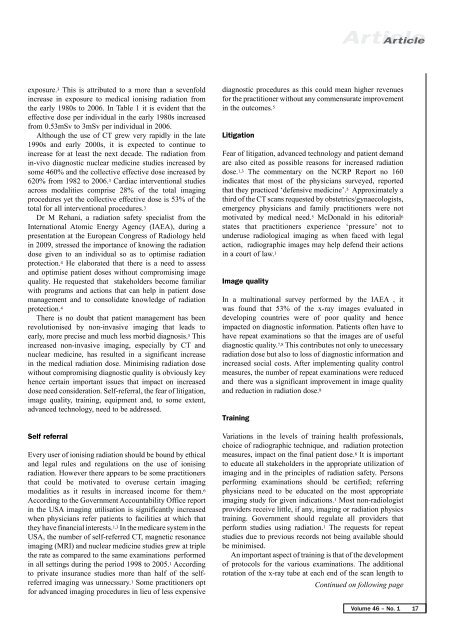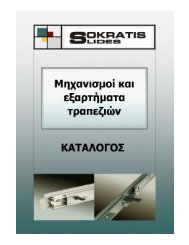isrrt Newsletter Volume 46. No.1 - 2010
Create successful ePaper yourself
Turn your PDF publications into a flip-book with our unique Google optimized e-Paper software.
Article<br />
exposure. 3 This is attributed to a more than a sevenfold<br />
increase in exposure to medical ionising radiation from<br />
the early 1980s to 2006. In Table 1 it is evident that the<br />
effective dose per individual in the early 1980s increased<br />
from 0.53mSv to 3mSv per individual in 2006.<br />
Although the use of CT grew very rapidly in the late<br />
1990s and early 2000s, it is expected to continue to<br />
increase for at least the next decade. The radiation from<br />
in-vivo diagnostic nuclear medicine studies increased by<br />
some 460% and the collective effective dose increased by<br />
620% from 1982 to 2006. 3 Cardiac interventional studies<br />
across modalities comprise 28% of the total imaging<br />
procedures yet the collective effective dose is 53% of the<br />
total for all interventional procedures. 3<br />
Dr M Rehani, a radiation safety specialist from the<br />
International Atomic Energy Agency (IAEA), during a<br />
presentation at the European Congress of Radiology held<br />
in 2009, stressed the importance of knowing the radiation<br />
dose given to an individual so as to optimise radiation<br />
protection. 4 He elaborated that there is a need to assess<br />
and optimise patient doses without compromising image<br />
quality. He requested that stakeholders become familiar<br />
with programs and actions that can help in patient dose<br />
management and to consolidate knowledge of radiation<br />
protection. 4<br />
There is no doubt that patient management has been<br />
revolutionised by non-invasive imaging that leads to<br />
early, more precise and much less morbid diagnosis. 5 This<br />
increased non-invasive imaging, especially by CT and<br />
nuclear medicine, has resulted in a significant increase<br />
in the medical radiation dose. Minimising radiation dose<br />
without compromising diagnostic quality is obviously key<br />
hence certain important issues that impact on increased<br />
dose need consideration. Self-referral, the fear of litigation,<br />
image quality, training, equipment and, to some extent,<br />
advanced technology, need to be addressed.<br />
Self referral<br />
Every user of ionising radiation should be bound by ethical<br />
and legal rules and regulations on the use of ionising<br />
radiation. However there appears to be some practitioners<br />
that could be motivated to overuse certain imaging<br />
modalities as it results in increased income for them. 6<br />
According to the Government Accountability Office report<br />
in the USA imaging utilisation is significantly increased<br />
when physicians refer patients to facilities at which that<br />
they have financial interests. 1,3 In the medicare system in the<br />
USA, the number of self-referred CT, magnetic resonance<br />
imaging (MRI) and nuclear medicine studies grew at triple<br />
the rate as compared to the same examinations performed<br />
in all settings during the period 1998 to 2005. 1 According<br />
to private insurance studies more than half of the selfreferred<br />
imaging was unnecssary. 1 Some practitioners opt<br />
for advanced imaging procedures in lieu of less expensive<br />
diagnostic procedures as this could mean higher revenues<br />
for the practitioner without any commensurate improvement<br />
in the outcomes. 5<br />
Litigation<br />
Fear of litigation, advanced technology and patient demand<br />
are also cited as possible reasons for increased radiation<br />
dose. 1,3 The commentary on the NCRP Report no 160<br />
indicates that most of the physicians surveyed, reported<br />
that they practiced ‘defensive medicine’. 5 Approximately a<br />
third of the CT scans requested by obstetrics/gynaecologists,<br />
emergency physicians and family practitioners were not<br />
motivated by medical need. 5 McDonald in his editorial 6<br />
states that practitioners experience ‘pressure’ not to<br />
underuse radiological imaging as when faced with legal<br />
action, radiographic images may help defend their actions<br />
in a court of law. 1<br />
Image quality<br />
In a multinational survey performed by the IAEA , it<br />
was found that 53% of the x-ray images evaluated in<br />
developing countries were of poor quality and hence<br />
impacted on diagnostic information. Patients often have to<br />
have repeat examinations so that the images are of useful<br />
diagnostic quality. 7,8 This contributes not only to unecessary<br />
radiation dose but also to loss of diagnostic information and<br />
increased social costs. After implementing quality control<br />
measures, the number of repeat examinations were reduced<br />
and there was a significant improvement in image quality<br />
and reduction in radiation dose. 8<br />
Training<br />
Variations in the levels of training health professionals,<br />
choice of radiographic technique, and radiation protection<br />
measures, impact on the final patient dose. 8 It is important<br />
to educate all stakeholders in the appropriate utilization of<br />
imaging and in the principles of radiation safety. Persons<br />
performing examinations should be certified; referring<br />
physicians need to be educated on the most appropriate<br />
imaging study for given indications. 1 Most non-radiologist<br />
providers receive little, if any, imaging or radiation physics<br />
training. Government should regulate all providers that<br />
perform studies using radiation. 1 The requests for repeat<br />
studies due to previous records not being available should<br />
be minimised.<br />
An important aspect of training is that of the development<br />
of protocols for the various examinations. The additional<br />
rotation of the x-ray tube at each end of the scan length to<br />
Continued on following page<br />
<strong>Volume</strong> 46 – No. 1 17

















